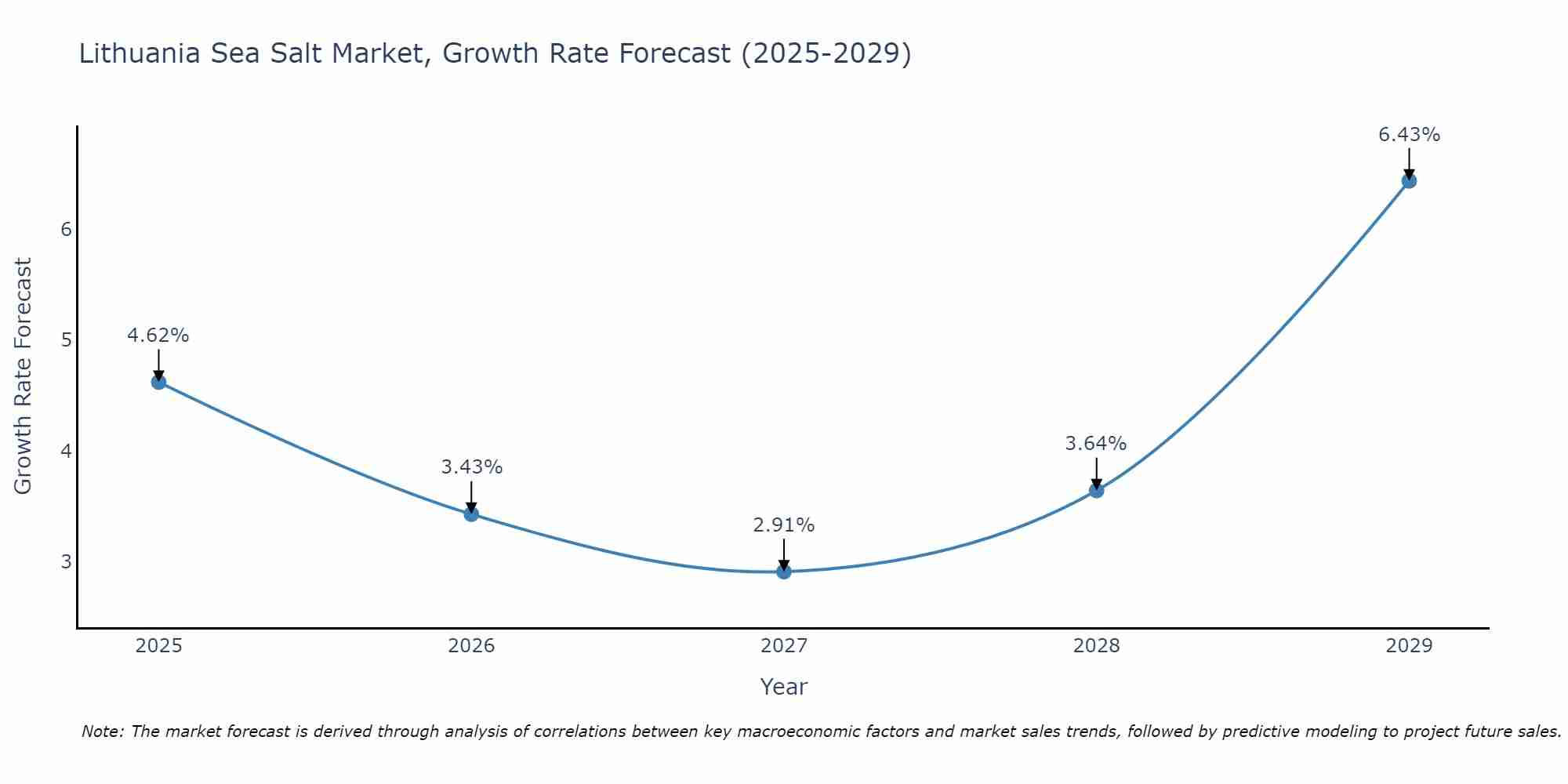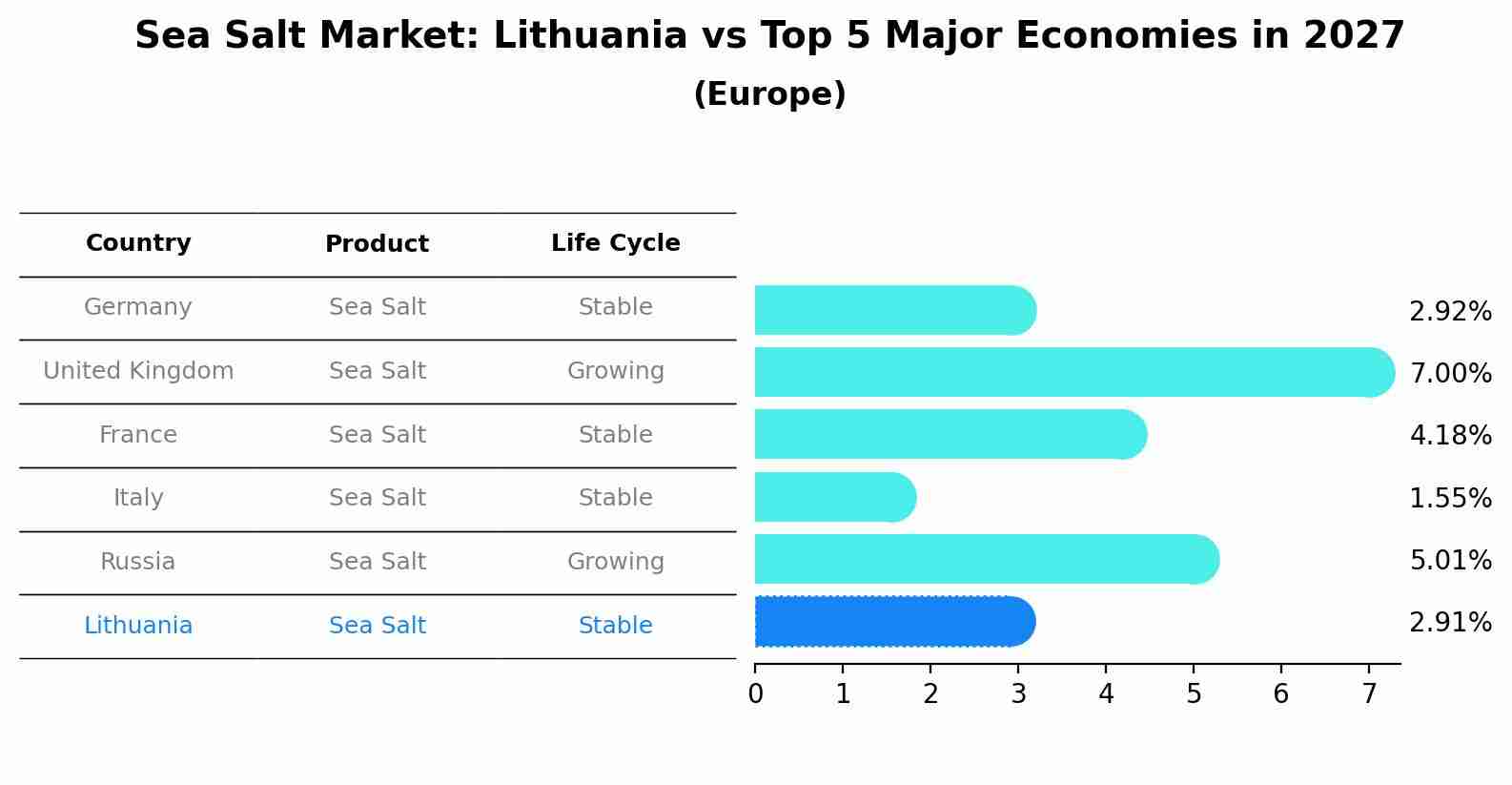Lithuania Sea Salt Market (2025-2031) | Growth, Revenue, Share, Value, Trends, Segmentation, Forecast, Outlook, Analysis, Companies, Size & Industry
| Product Code: ETC5212994 | Publication Date: Nov 2023 | Updated Date: Sep 2025 | Product Type: Market Research Report | |
| Publisher: 6Wresearch | No. of Pages: 60 | No. of Figures: 30 | No. of Tables: 5 | |
Lithuania Sea Salt Market Size Growth Rate
The Lithuania Sea Salt Market is projected to witness mixed growth rate patterns during 2025 to 2029. From 4.62% in 2025, the growth rate steadily ascends to 6.43% in 2029.

Sea Salt Market: Lithuania vs Top 5 Major Economies in 2027 (Europe)
The Sea Salt market in Lithuania is projected to grow at a stable growth rate of 2.91% by 2027, highlighting the country's increasing focus on advanced technologies within the Europe region, where Germany holds the dominant position, followed closely by United Kingdom, France, Italy and Russia, shaping overall regional demand.

Key Highlights of the Report:
- Lithuania Sea Salt Market Outlook
- Market Size of Lithuania Sea Salt Market, 2024
- Forecast of Lithuania Sea Salt Market, 2031
- Historical Data and Forecast of Lithuania Sea Salt Revenues & Volume for the Period 2021-2031
- Lithuania Sea Salt Market Trend Evolution
- Lithuania Sea Salt Market Drivers and Challenges
- Lithuania Sea Salt Price Trends
- Lithuania Sea Salt Porter`s Five Forces
- Lithuania Sea Salt Industry Life Cycle
- Historical Data and Forecast of Lithuania Sea Salt Market Revenues & Volume By Distribution Channel for the Period 2021-2031
- Historical Data and Forecast of Lithuania Sea Salt Market Revenues & Volume By Direct/BB for the Period 2021-2031
- Historical Data and Forecast of Lithuania Sea Salt Market Revenues & Volume By Indirect/B2C for the Period 2021-2031
- Historical Data and Forecast of Lithuania Sea Salt Market Revenues & Volume By End Use for the Period 2021-2031
- Historical Data and Forecast of Lithuania Sea Salt Market Revenues & Volume By Agriculture for the Period 2021-2031
- Historical Data and Forecast of Lithuania Sea Salt Market Revenues & Volume By Cosmetics for the Period 2021-2031
- Historical Data and Forecast of Lithuania Sea Salt Market Revenues & Volume By Animal Feed for the Period 2021-2031
- Historical Data and Forecast of Lithuania Sea Salt Market Revenues & Volume By Horeca for the Period 2021-2031
- Historical Data and Forecast of Lithuania Sea Salt Market Revenues & Volume By Food Industry for the Period 2021-2031
- Lithuania Sea Salt Import Export Trade Statistics
- Market Opportunity Assessment By Distribution Channel
- Market Opportunity Assessment By End Use
- Lithuania Sea Salt Top Companies Market Share
- Lithuania Sea Salt Competitive Benchmarking By Technical and Operational Parameters
- Lithuania Sea Salt Company Profiles
- Lithuania Sea Salt Key Strategic Recommendations
Frequently Asked Questions About the Market Study (FAQs):
1 Executive Summary |
2 Introduction |
2.1 Key Highlights of the Report |
2.2 Report Description |
2.3 Market Scope & Segmentation |
2.4 Research Methodology |
2.5 Assumptions |
3 Lithuania Sea Salt Market Overview |
3.1 Lithuania Country Macro Economic Indicators |
3.2 Lithuania Sea Salt Market Revenues & Volume, 2021 & 2031F |
3.3 Lithuania Sea Salt Market - Industry Life Cycle |
3.4 Lithuania Sea Salt Market - Porter's Five Forces |
3.5 Lithuania Sea Salt Market Revenues & Volume Share, By Distribution Channel, 2021 & 2031F |
3.6 Lithuania Sea Salt Market Revenues & Volume Share, By End Use, 2021 & 2031F |
4 Lithuania Sea Salt Market Dynamics |
4.1 Impact Analysis |
4.2 Market Drivers |
4.2.1 Increasing consumer awareness about the health benefits of using sea salt over table salt |
4.2.2 Growing demand for natural and organic food products |
4.2.3 Rising popularity of gourmet and specialty salts in culinary applications |
4.3 Market Restraints |
4.3.1 Limited domestic production capacity of sea salt in Lithuania |
4.3.2 Price volatility of sea salt due to factors like weather conditions and global market trends |
5 Lithuania Sea Salt Market Trends |
6 Lithuania Sea Salt Market Segmentations |
6.1 Lithuania Sea Salt Market, By Distribution Channel |
6.1.1 Overview and Analysis |
6.1.2 Lithuania Sea Salt Market Revenues & Volume, By Direct/BB, 2021-2031F |
6.1.3 Lithuania Sea Salt Market Revenues & Volume, By Indirect/B2C, 2021-2031F |
6.2 Lithuania Sea Salt Market, By End Use |
6.2.1 Overview and Analysis |
6.2.2 Lithuania Sea Salt Market Revenues & Volume, By Agriculture, 2021-2031F |
6.2.3 Lithuania Sea Salt Market Revenues & Volume, By Cosmetics, 2021-2031F |
6.2.4 Lithuania Sea Salt Market Revenues & Volume, By Animal Feed, 2021-2031F |
6.2.5 Lithuania Sea Salt Market Revenues & Volume, By Horeca, 2021-2031F |
6.2.6 Lithuania Sea Salt Market Revenues & Volume, By Food Industry, 2021-2031F |
7 Lithuania Sea Salt Market Import-Export Trade Statistics |
7.1 Lithuania Sea Salt Market Export to Major Countries |
7.2 Lithuania Sea Salt Market Imports from Major Countries |
8 Lithuania Sea Salt Market Key Performance Indicators |
8.1 Number of new product launches featuring sea salt as an ingredient in the Lithuanian market |
8.2 Consumer surveys indicating preference for sea salt-based products |
8.3 Growth in the number of specialty stores and restaurants offering sea salt products |
9 Lithuania Sea Salt Market - Opportunity Assessment |
9.1 Lithuania Sea Salt Market Opportunity Assessment, By Distribution Channel, 2021 & 2031F |
9.2 Lithuania Sea Salt Market Opportunity Assessment, By End Use, 2021 & 2031F |
10 Lithuania Sea Salt Market - Competitive Landscape |
10.1 Lithuania Sea Salt Market Revenue Share, By Companies, 2024 |
10.2 Lithuania Sea Salt Market Competitive Benchmarking, By Operating and Technical Parameters |
11 Company Profiles |
12 Recommendations | 13 Disclaimer |
- Single User License$ 1,995
- Department License$ 2,400
- Site License$ 3,120
- Global License$ 3,795
Search
Related Reports
- Saudi Arabia Manlift Market (2025-2031) | Outlook, Size, Growth, Trends, Companies, Industry, Revenue, Value, Share, Forecast & Analysis
- Uganda Excavator, Crane, and Wheel Loaders Market (2025-2029) | Strategy, Consumer Insights, Analysis, Investment Trends, Opportunities, Growth, Size, Share, Industry, Revenue, Segments, Value, Segmentation, Supply, Forecast, Restraints, Outlook, Competition, Drivers, Trends, Demand, Pricing Analysis, Competitive, Strategic Insights, Companies, Challenges
- Rwanda Excavator, Crane, and Wheel Loaders Market (2025-2031) | Strategy, Consumer Insights, Analysis, Investment Trends, Opportunities, Growth, Size, Share, Industry, Revenue, Segments, Value, Segmentation, Supply, Forecast, Restraints, Outlook, Competition, Drivers, Trends, Demand, Pricing Analysis, Competitive, Strategic Insights, Companies, Challenges
- Kenya Excavator, Crane, and Wheel Loaders Market (2025-2031) | Strategy, Consumer Insights, Analysis, Investment Trends, Opportunities, Growth, Size, Share, Industry, Revenue, Segments, Value, Segmentation, Supply, Forecast, Restraints, Outlook, Competition, Drivers, Trends, Demand, Pricing Analysis, Competitive, Strategic Insights, Companies, Challenges
- Angola Excavator, Crane, and Wheel Loaders Market (2025-2031) | Strategy, Consumer Insights, Analysis, Investment Trends, Opportunities, Growth, Size, Share, Industry, Revenue, Segments, Value, Segmentation, Supply, Forecast, Restraints, Outlook, Competition, Drivers, Trends, Demand, Pricing Analysis, Competitive, Strategic Insights, Companies, Challenges
- Israel Intelligent Transport System Market (2025-2031) | Strategy, Consumer Insights, Analysis, Investment Trends, Opportunities, Growth, Size, Share, Industry, Revenue, Segments, Value, Segmentation, Supply, Forecast, Restraints, Outlook, Competition, Drivers, Trends, Demand, Pricing Analysis, Competitive, Strategic Insights, Companies, Challenges
- Uganda Precast and Aggregate Market (2025-2031) | Strategy, Consumer Insights, Analysis, Investment Trends, Opportunities, Growth, Size, Share, Industry, Revenue, Segments, Value, Segmentation, Supply, Forecast, Restraints, Outlook, Competition, Drivers, Trends, Demand, Pricing Analysis, Competitive, Strategic Insights, Companies, Challenges
- Australia IT Asset Disposal Market (2025-2031) | Strategy, Consumer Insights, Analysis, Investment Trends, Opportunities, Growth, Size, Share, Industry, Revenue, Segments, Value, Segmentation, Supply, Forecast, Restraints, Outlook, Competition, Drivers, Trends, Demand, Pricing Analysis, Competitive, Strategic Insights, Companies, Challenges
- UAE Building Thermal Insulation Market Outlook (2025-2031) | Revenue, Companies, Share, Trends, Growth, Size, Forecast, Industry, Analysis & Value
- Portugal Electronic Document Management Market (2025-2031) | Strategy, Consumer Insights, Analysis, Investment Trends, Opportunities, Growth, Size, Share, Industry, Revenue, Segments, Value, Segmentation, Supply, Forecast, Restraints, Outlook, Competition, Drivers, Trends, Demand, Pricing Analysis, Competitive, Strategic Insights, Companies, Challenges
Industry Events and Analyst Meet
Our Clients
Whitepaper
- Middle East & Africa Commercial Security Market Click here to view more.
- Middle East & Africa Fire Safety Systems & Equipment Market Click here to view more.
- GCC Drone Market Click here to view more.
- Middle East Lighting Fixture Market Click here to view more.
- GCC Physical & Perimeter Security Market Click here to view more.
6WResearch In News
- Doha a strategic location for EV manufacturing hub: IPA Qatar
- Demand for luxury TVs surging in the GCC, says Samsung
- Empowering Growth: The Thriving Journey of Bangladesh’s Cable Industry
- Demand for luxury TVs surging in the GCC, says Samsung
- Video call with a traditional healer? Once unthinkable, it’s now common in South Africa
- Intelligent Buildings To Smooth GCC’s Path To Net Zero













